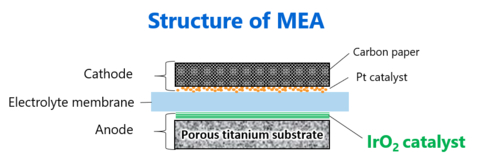Promoting PEM water electrolyzers for power to gas technology that will contribute to realization of a hydrogen economy
Toshiba Corporation (TOKYO: 6502) has developed large-scale production technology for the electrodes that realizes high level efficiency in Power to Gas (P2G) technology, essential know-how for advancing toward a carbon neutral society, while reducing the use of iridium, one of the world’s rarest precious metals, to 1/10*1.
This press release features multimedia. View the full release here: https://www.businesswire.com/news/home/20221006005600/en/

Figure 1: Structure of MEA (Graphic: Business Wire)
P2G uses electrolysis of water to convert renewable energy into hydrogen, for storage and transportation to where it is needed. Polymer Electrolyte Membrane (PEM) electrolysis is seen as a highly promising conversion method, as it is reacts rapidly to power fluctuations and is highly durable. However, PEM uses iridium, one of the rarest of all traded precious metals, as the catalyst in its electrodes. Practical application requires reduction of the iridium used, a real challenge.
Toshiba developed an iridium oxide nanosheet laminated catalyst that reduced the iridium requirement to 1/10 in 2017. The company has now developed large-scale production technology that deposits the catalyst over a maximum area of 5m2 at one time. This advance is expected to drive forward the early commercialization of P2G for large-scale power conversion, and will contribute to the realization of carbon neutrality. Toshiba is aiming for commercialization in FY2023 or after.
Over 120 countries and regions have set themselves the goal of carbon neutrality by 2050, and decarbonization measures are being considered at the national, regional, and corporate levels. Renewables are essential for achieving the goal and cutting CO2 emissions, but their output fluctuates greatly with climate and weather conditions, and facilities can be located only in suitable regions. To maximize their potential, and ensure a stable and affordable power supply, a method for storing and transporting electricity from renewables is required.
P2G is seen as an essential solution for achieving carbon neutrality by 2050. It uses electrolysis to convert electricity from renewables into hydrogen, ready for storage and transportation. The key technology in the process is the water electrolyzers that convert energy into hydrogen without emitting CO2. PEM water electrolysis, which offers excellent adaptability to power fluctuations and high durability, and Europe and the US have led the way in developing the current process.
PEM uses a membrane electrode assembly (MEA) that integrates the electrolyte membrane and electrode (Fig. 1). Large-scale hydrogen conversion of electricity requires a large number of MEAs, and forecasts anticipate a market scale of approximately $580 million by 2028*2.
However, the MEA electrode relies on a large amount of iridium to ensure sufficient electrolytic efficiency. Iridium is one of the rarest of precious metals. Annual global production is in the region of 7 to 10 tons, far less than the 200 tons of platinum, and it costs four to five times more*3. Forming electrodes requires a uniform coating of fine iridium oxide particles, but reducing the iridium oxide results in uneven application and non-uniform reactions that degrade water electrolysis performance.
Toshiba’s multilayer catalyst uses a new sputtering technology (Fig. 2) to deposit alternate layers of iridium oxide nanosheet films and void layers (Fig. 3). In sputtering, ions, such as argon, bombard a deposition material, the target, in a vacuum, and deposit the ejected particles on a substrate (Fig. 2). In Toshiba’s process, iridium is the target, and a thin film of iridium oxide is formed by injecting oxygen as the target is deposited on the substrate. Thickness control is at the nanometer level, realizing deposition of uniform iridium oxide layers of with a smaller amount of iridium.
Using Toshiba's laminated nanosheet structure in the catalyst layer successfully reduces the required iridium to 1/10, while maintaining the water electrolysis performance (Fig. 4). It also significantly expands the deposition surface area. As sputtering is conducted in a vacuum, deposition on a large area is difficult. However, by modifying the deposition distribution ratio for multiple metal targets, including iridium, and the oxygen input level, Toshiba has successfully developed a large-scale production technology that realizes catalyst deposition on an area of up to 5m2 at a time (Fig. 5).
In collaboration with Toshiba Energy Systems & Solutions Corporation, Toshiba has built MEA prototypes with electrodes based on the developed technology, and has begun evaluation testing with a water electrolyzer manufacturer. Going forward, the Company will improve the yield and quality toward mass production of MEA, aiming for commercialization in FY2023 or after.
*1: https://www.global.toshiba/content/dam/toshiba/migration/corp/techReviewAssets/tech/review/2018/03/73_03pdf/a03.pdf
https://www.global.toshiba/content/dam/toshiba/jp/technology/corporate/review/2022/04/a04.pdf
*2: Toshiba’s estimate
*3: https://matthey.com/pgm-market-report-2022
View source version on businesswire.com: https://www.businesswire.com/news/home/20221006005600/en/
Contacts
Media:
Samantha Smoak
ssmoak@pancomm.com














